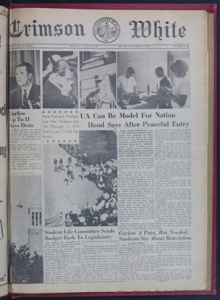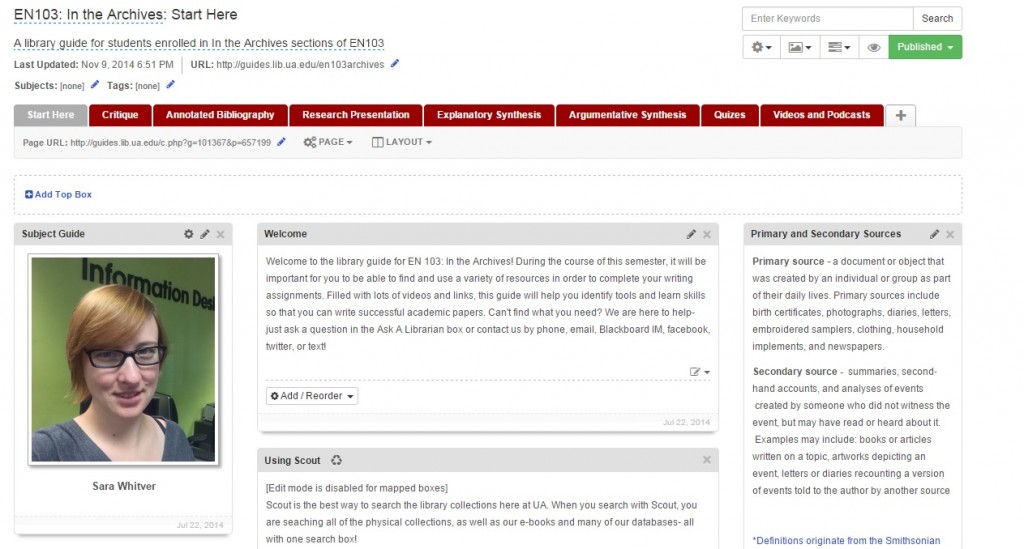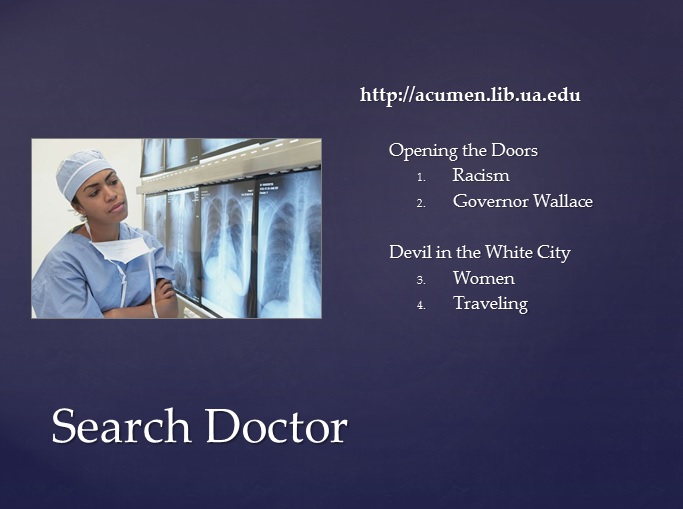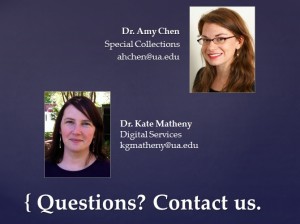By: Amy Chen, CLIR Postdoctoral Fellow, and Kate Matheny, IT Technical Specialist I
On Monday, we discussed the collaboration between Amy and Brooke that led to this fall’s “In the Archive” themed Honors First-Year Writing classes. Today, we’re covering what Brooke and Amy — now joined by Kate Matheny, the Outreach Coordinator for Digital Services, and Sara Whitver, the First-Year Experience librarian, decided to do to support these sections.
During our meeting in July, we decided we needed to do the following:
- Instead of creating three different LibGuides — individually authored by Sara, Amy, and Kate — Amy and Kate would simply add content to Sara’s pre-existing LibGuide, which can be seen above.
- A session on using Acumen was integrated with the students’ normal schedule of library information sessions. In addition to two library sessions dedicated to general information literacy principle, focusing on resources and services available in Gorgas, Alabama’s general collections library, a third library session would be shared by Amy and Kate.
- In that third library session, Amy would reiterate that in special collections, what is a primary source and what is a secondary source often is defined not by the inherent qualities of the item itself, but rather by the type of question that is being asked; ask students to model creating thesis statements from the sources they found rather than predetermining their argument and then finding primary and secondary materials that matched their ideas; and discuss what special collections is and what the strengths of UA’s repositories were. Kate would then discuss how to discover items in Acumen; lead a “search doctor” activity, showing students how to find materials by refining their searches; and outline the ways in which Acumen differs from popular browsers, such as Google.
Now that Amy and Kate have taught all their sections of Honors First-Year Writing, we thought we’d take the opportunity to reflect on how this collaboration went, what we liked about the semester, and what we plan to do differently in the future.
Amy’s Perspective
Amy felt that this collaboration expanded the number of students the Division of Special Collections was able to reach. She appreciated that Kate was able to teach her — as well as the students from these sections — the ins and outs of searching Acumen. She was also thankful to Sara for creating such comprehensive and valuable LibGuides for the Honors FYW students and for organizing the scheduling and topics of the three library sessions offered.

Crimson White, downloaded from Acumen
In the future, Amy thinks that using the digital repository is an excellent options for students. She plans to advise professors that are interested in shorter or less challenging assignments that using the digital repository is a way to contain the “overwhelm” students feel when having to learn how to navigate a new type of library — online sources are simply more friendly to our tech-savvy students. However, she will continue to direct professors who are interested in having students get hands-on experience with our collections to come in to the reading room. What she’d like to do differently in the future is to include a learning module on how digital surrogates differ from physical objects and what is lost and gained in this translation. It might also be fun to create learning modules on digitized resources available at other institutions’ special collections repositories.
Kate’s Perspective
Kate thought the collaboration was a good way to introduce the students to primary source research, including digital surrogates. Though they would be using digitized materials, it was vital that they see it in the greater context of archival research, both for their current course and in general. Just teaching how to use the tool would not have been adequate; these students also needed to learn what makes special collections materials so special — challenging but rewarding. There was no better person to approach that aspect of the instruction than Amy.
The co-teaching model worked well. Not only did it put more friendly faces into the classroom, but it allowed us to shore up each other’s lectures with observations and commentary, keeping the mood more open and informal in a setting where there was not much time for extensive discussion. The presentation-heavy nature of the sessions was a bit of a drawback, but in the future it could be mitigated by providing some of the instruction by asynchronous means. Introducing concepts through more in-depth LibGuides, interactive tutorials, or videos before (and after) the session would leave class time for demonstration and practice.
This kind of balancing act between covering the scope of the subject and providing targeted, assignment-based instruction is something the regular instruction librarians are well used to, so it was especially helpful to have Sara’s guidance. Not only could she help us keep sight of the big picture; she also facilitated the creation of our cooperative LibGuide, allowing us to draw on established content and spend our efforts contributing more specialized content appropriate to our focus. Brooke’s input into the session creation process was also invaluable as it gave us an outside perspective on the parameters of the session while simultaneously allowing us an insider’s look at the students, their aptitudes and needs.



